
Posted on August 6, 2018
A proposal by the U.S. Fish and Wildlife Service to expand the boundaries of protected land in Cape May County’s Hereford Inlet could complicate future beach replenishment projects in Avalon, North Wildwood and Stone Harbor.
The proposal would ban the use of nonemergency federal dollars for dredging in Hereford Inlet, which is where the U.S. Army Corps for Engineers gets sand for replenishment projects for North Wildwood and Stone Harbor. The ban also would encompass part of North Wildwood’s seawall on the north end of the island.
“In our opinion, this is an incredible overreach,” North Wildwood Mayor Patrick Rosenello said of the proposal. “I’m hard-pressed to understand what the reasoning behind this is.”
The U.S. Fish and Wildlife Service did not return a request for comment.
The ban would legally fall under the Coastal Barrier Resources Act, which was passed by Congress in 1982 and aims to conserve hurricane-prone, biologically rich coastal barriers by discouraging economic development.
Areas that fall under the federal law can still be developed, however, if the towns or state pays for it.
Avalon, Stone Harbor and the Army Corps also oppose the plan and submitted letters of opposition to the U.S. Fish and Wildlife Service during the public comment period, which ended July 10.
Avalon gets its sand from Townsends Inlet for beach replenishment, but it has partnered with Stone Harbor for certain replenishment projects, Avalon administrator Scott Wahl said.
“It has been past practice to let (the Army Corps) use sand there for beachfill projects,” Wahl said. “You will still be able to use sand from there if you use local dollars, so where exactly is the environmental argument to all of this?”
This is not the first time the three towns have been at odds with the U.S. Fish and Wildlife Service. In 2016, the USFWS tried to prevent them from using sand for other beach replenishment projects.
The towns sued in federal court, but ended the litigation after a deal was struck to bring sand down from the Townsends Inlet. That cost $6 million more than it would have cost to dredge the sand from Hereford Inlet. The cost was shared by the Army Corps, the New Jersey Department of Environmental Protection and the towns.
“That was shortly after Winter Storm Jonas, so we all got hammered,” Wahl said. “The borrow area in Townsends Inlet even had to be expanded (to accommodate those projects).”
If the USFWS moves forward with its proposal, officials say they will re-file the federal lawsuit. But any changes to barriers under the Coastal Barrier Resources Act are only official if Congress approves them.
A spokesman for U.S. Rep. Frank LoBiondo, R-2nd, said the congressman opposes the proposed changes.
Erik Rourke, a project manager at the Army Corps district that covers South Jersey, said if the Hereford Inlet ban moves forward, the Army Corps will have to find a new spot to get sand from, which could cost more money.
“The periodic beach replenishment will come from Townsends Inlet or another location (if the ban on Hereford Inlet moves forward),” Rourke said. “We’ve had discussions with the (USFWS), so we’ll see soon how they respond.”
Source: pressofatlanticcity





